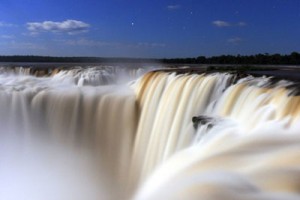 Alvar Nunez Cabeza de Vaca was the first explorer of the Old World saw these falls. The called “Salto de Santa Maria”, but his baptism was unlucky and end up taking the name Niagara River that feeds: Iguazu Guarani language that does “big water”. Iguazu Falls are the largest of the Earth, its flow and extension. They consist of a variable number of waterfalls, ranging from 160 in the dry season to the 275 recorded in the rainiest season, between November and March. The average height of the jumps exceeds 70 meters.
Alvar Nunez Cabeza de Vaca was the first explorer of the Old World saw these falls. The called “Salto de Santa Maria”, but his baptism was unlucky and end up taking the name Niagara River that feeds: Iguazu Guarani language that does “big water”. Iguazu Falls are the largest of the Earth, its flow and extension. They consist of a variable number of waterfalls, ranging from 160 in the dry season to the 275 recorded in the rainiest season, between November and March. The average height of the jumps exceeds 70 meters.
The phenomenon originated two hundred thousand years ago, when a fault produced in the mouth of the Iguazu River made its waters despeñaran by a fall of over 80 meters high. The continued erosion suffered by the area for thousands of years has made today the falls are situated 23 kilometers before the original place. The show is prodigious: a big double array of waterfalls in a jungle where they are known to live 80 species of mammals, including the jaguar, and 450 species of birds, including toucans, parrots and swifts that cross over and over again queues for food and water to return to the nest.
The falls were declared a Unesco World Heritage Site in 1984. They form the border between Brazil and Argentina. The most panoramic views are obtained from the Brazilian side, where they were fi lmadas initial images of the movie “The Mission”. The Itaipu hydroelectric dam nearby, marked path in 1991, uses the force of the falls to rise more than 40 percent of the electricity consumed by Brazil, Paraguay and Argentina.



